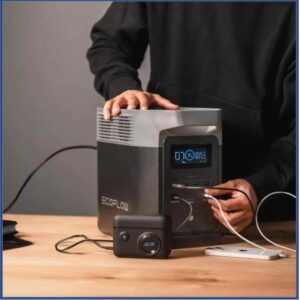Finding the right portable power station begins with understanding how you plan to use it. Some need it just to keep phones and laptops charged during outages, while others require enough power for fans, CPAP machines, or small appliances on trips. Avoid getting distracted by flashy ads or features you may never use. Focus instead on how well the station fits your routine, emergencies, and recharge patience. In this article, you will learn how to confidently compare battery capacity, output options, charging speed, and real-world convenience before buying.
Battery Capacity and Power: Your Energy Core
Understanding Watt-Hours (Wh) for Battery Life
Watt-hours (Wh) are the most important number when comparing battery capacity because they tell you how long the station will actually run your devices. A 500Wh unit can theoretically deliver 500 watts for one hour, or 50 watts for ten hours, but real-world usage is slightly lower due to conversion loss. Instead of guessing, think through common scenarios such as charging a phone every night, running a desk fan for a few hours, or powering a mini-fridge during a blackout. If you know roughly how much energy your essentials consume, you can quickly tell whether a smaller or larger capacity fits your lifestyle. Many people overestimate how much power they need, so choosing based on actual habits prevents overspending or carrying unnecessary weight.
Comparing Running Watts and Starting Watts
Running watts refer to how much power the station can provide continuously, while starting watts are the brief surge it can handle when devices like blenders or pumps first power on. Some equipment needs two or three times more power at startup, even if run at low wattage afterward. If you plan to plug in anything with a motor or compressor, make sure the station’s starting watt rating clearly exceeds those demands. Even for basic electronics like laptops or mini projectors, knowing the running limit helps prevent accidental overload or sudden shutdowns during use. Checking both numbers ensures smooth operation rather than discovering too late that your device flickers off the moment it turns on.

Output Ports: What Can You Power?
Output ports determine what devices you can connect without juggling adapters or constantly swapping cables. Most people use a mix of AC outlets for larger gadgets, USB ports for phones and tablets, and DC outputs for car-style accessories or portable coolers. A good station should provide a balance rather than favor one type too heavily, allowing multiple devices to run at once without conflict. Consider your daily and emergency habits: Do you prefer charging everything via USB-C? Do you rely on a plug-in fan while sleeping? Do you often entertain with speakers or projectors? Having the right ports removes hassle and makes the station feel like a natural extension of your home or travel setup rather than an awkward tool you constantly need to work around.
Charging Options and Speed: Refueling Your Station
Solar Charging Capability and Input Power
Solar charging is one of the most freeing features a portable power station can offer, but it depends heavily on input rating and panel compatibility. A station that accepts only low wattage from solar panels will take all day—or even multiple days—to fill up, which may be fine for relaxed camping but frustrating in emergencies. Higher solar input allows faster recovery, especially on bright days when you want to collect as much energy as possible before sunset. Even if you do not own panels yet, choosing a model that supports them keeps your future options open instead of locking you into wall charging forever. Renewable refueling can feel empowering, but it only works well when the station is built to take full advantage of sunlight.
Wall, Car, and Generator Charging Times
Wall charging is usually the fastest method, but not all stations recharge at the same pace, and some take over eight hours even from a standard outlet. If you live in an area with frequent outages or rely on the station for medical or overnight use, faster recharging can make the difference between stress and peace of mind. Car charging comes in handy for road trips, but it is typically slow, so treat it as a top-up method rather than a full refill. Generator charging is useful for extended blackouts, yet it may require specific adapters, so double-check compatibility before you rely on it. Understanding how long each method takes helps you plan realistically rather than guessing and being disappointed.
Portability, Design, and Extra Features
Portability is not just about weight, but how easily you can move, store, and position the station in daily life. A solid handle makes a big difference when pulling it from a closet during a storm or carrying it across a parking lot. Some people prefer sleek designs that blend with living spaces rather than industrial-looking boxes that feel out of place in a bedroom. Built-in lights, wireless charging pads, or display screens showing real-time usage are not essential but greatly improve convenience. Even small touches like quiet fans and rubberized feet can determine whether you enjoy using it or treat it as an emergency-only item you reluctantly drag out.
Conclusion
Choosing the right portable power station is less about chasing the biggest battery and more about fitting your unique rhythm of life. A reliable unit should feel as easy to use as plugging in a phone charger, not something that requires constant monitoring or technical knowledge. In the portable power station market, brands like EcoFlow offer multiple options suitable for home backup, camping, RV trips, DIY projects, or emergencies, making it easier to match capacity with lifestyle rather than forcing a one-size-fits-all solution. Once you understand capacity, output ports, charging speed, and design, comparison becomes surprisingly simple. When you focus on practicality over hype, your final choice will not just be powerful—it will be genuinely useful whenever you need it most.


